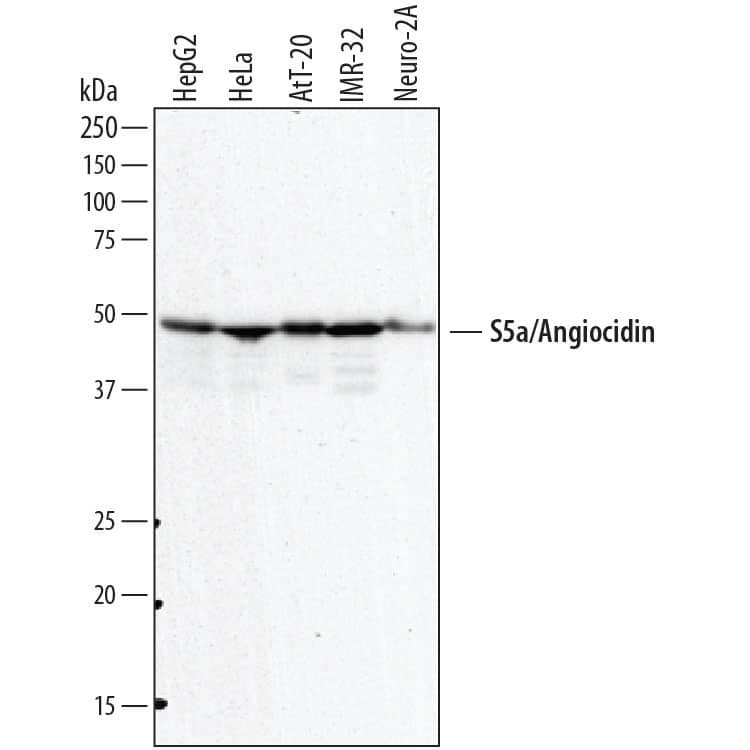Human/Mouse S5a/Angiocidin Antibody
R&D Systems, part of Bio-Techne | Catalog # AF8036

Key Product Details
Species Reactivity
Applications
Label
Antibody Source
Product Specifications
Immunogen
Met1-Lys377
Accession # P55036
Specificity
Clonality
Host
Isotype
Scientific Data Images for Human/Mouse S5a/Angiocidin Antibody
Detection of Human and Mouse S5a/Angiocidin by Western Blot.
Western blot shows lysates of HepG2 human hepatocellular carcinoma cell line, HeLa human cervical epithelial carcinoma cell line, AtT-20 mouse pituitary tumor cell line, IMR-32 human neuroblastoma cell line, and Neuro-2A mouse neuroblastoma cell line. PVDF membrane was probed with 2 µg/mL of Sheep Anti-Human/Mouse S5a/Angiocidin Antigen Affinity-purified Polyclonal Antibody (Catalog # AF8036) followed by HRP-conjugated Anti-Sheep IgG Secondary Antibody (Catalog # HAF016). A specific band was detected for S5a/Angiocidin at approximately 50 kDa (as indicated). This experiment was conducted under reducing conditions and using Immunoblot Buffer Group 1.Applications for Human/Mouse S5a/Angiocidin Antibody
Western Blot
Sample: HepG2 human hepatocellular carcinoma cell line, HeLa human cervical epithelial carcinoma cell line, AtT‑20 mouse pituitary tumor cell line, IMR‑32 human neuroblastoma cell line, and Neuro‑2A mouse neuroblastoma cell line
Formulation, Preparation, and Storage
Purification
Reconstitution
Formulation
Shipping
Stability & Storage
- 12 months from date of receipt, -20 to -70 °C as supplied.
- 1 month, 2 to 8 °C under sterile conditions after reconstitution.
- 6 months, -20 to -70 °C under sterile conditions after reconstitution.
Background: S5a/Angiocidin
S5a (26S proteasome regulatory subunit S5a/RPN10/nonATPase 4; also Angiocidin, ASF and multiubiquitin chain-binding protein) is a 50-60 kDa protein that belongs to the proteasome subunit S5A family of molecules. It is ubiquitously expressed, and found in both cytosol and in association with the 26S proteosome. Intracellularly, proteins targeted for degradation are marked by ubiquitin (Ub), a 9 kDa polypeptide. Following ubiquitination, proteins so marked are recognized by a degradation unit composed of three complexes, a central 20S complex and two flanking 19S complexes. The 20S barrel-shaped complex contains 28 subunits, one of which is S5a. This subunit binds Lys48 multiubiquitinated proteins, and contributes to proteosome-based proteolysis. S5a also binds proteins with intrinsic Ub-like sequences, and is posited to contribute to their degradation. Notably, S5a interacts with E3/E2 pairs to insure that non-forked Ub chains appear on target proteins. Failure to do so leads to forked Ub chains that are poor proteosome targets. S5a also exists in the circulation, and appears to bind TSP-1. Extracellularly, S5a is reported to possess both antiangiogenic and antiproliferative activity, and to promote inflammatory mediator secretion from mononuclear cells. Human S5a is synthesized as a 377 amino acid (aa) protein that contains one vWF-A type domain (aa 5-188) and two UIM, or Ub-interacting motifs (aa 211-230 and 282-301). There are at least three utilized Ser phosphorylation sites. Although mouse S5a has four reported splice forms, human appears to have but two, one that contains a GlyGluArg insertion after Glu254 (called angiocidin), and a second 32-33 kDa isoform that exists in the embryo and contains a 14 aa substitution for aa 255-377. Full-length human S5a shares 96% aa sequence identity with mouse S5a.
Long Name
Alternate Names
Gene Symbol
UniProt
Additional S5a/Angiocidin Products
Product Documents for Human/Mouse S5a/Angiocidin Antibody
Product Specific Notices for Human/Mouse S5a/Angiocidin Antibody
For research use only
